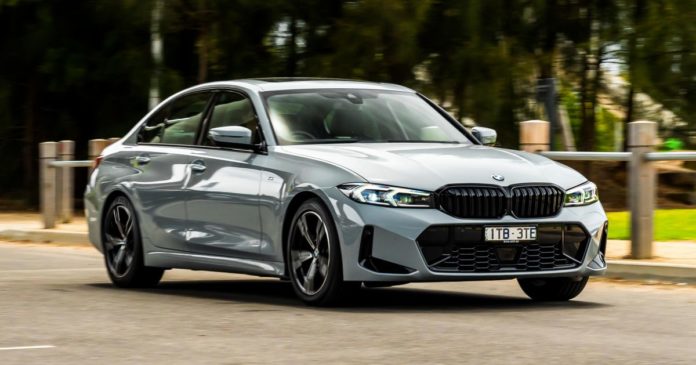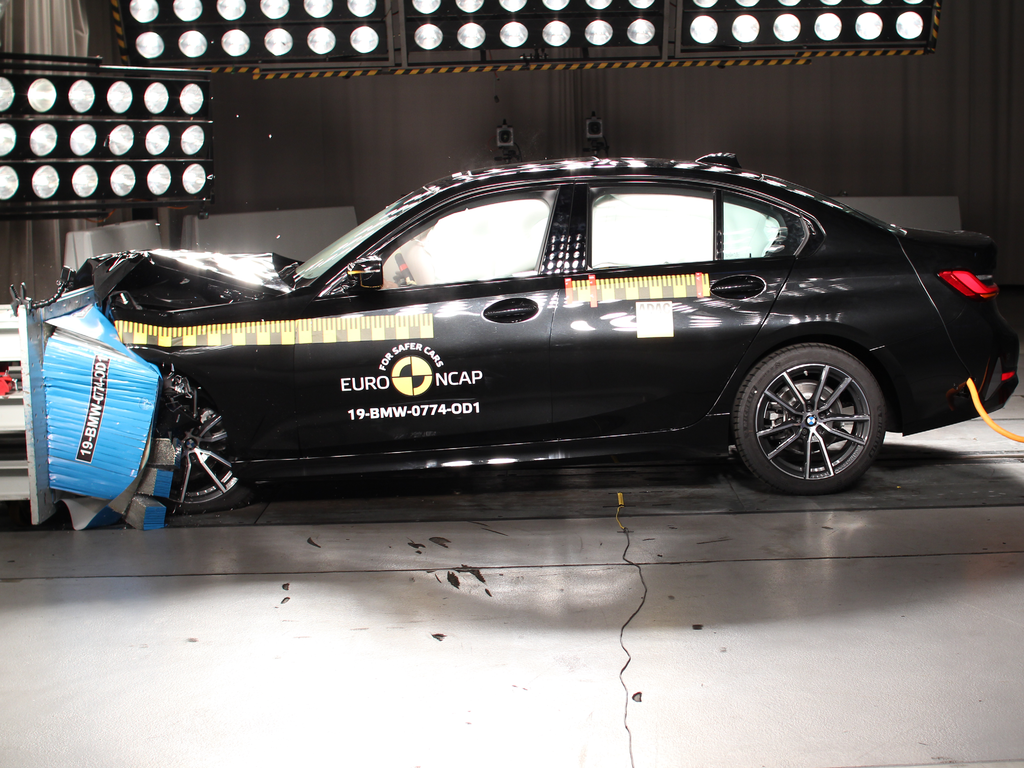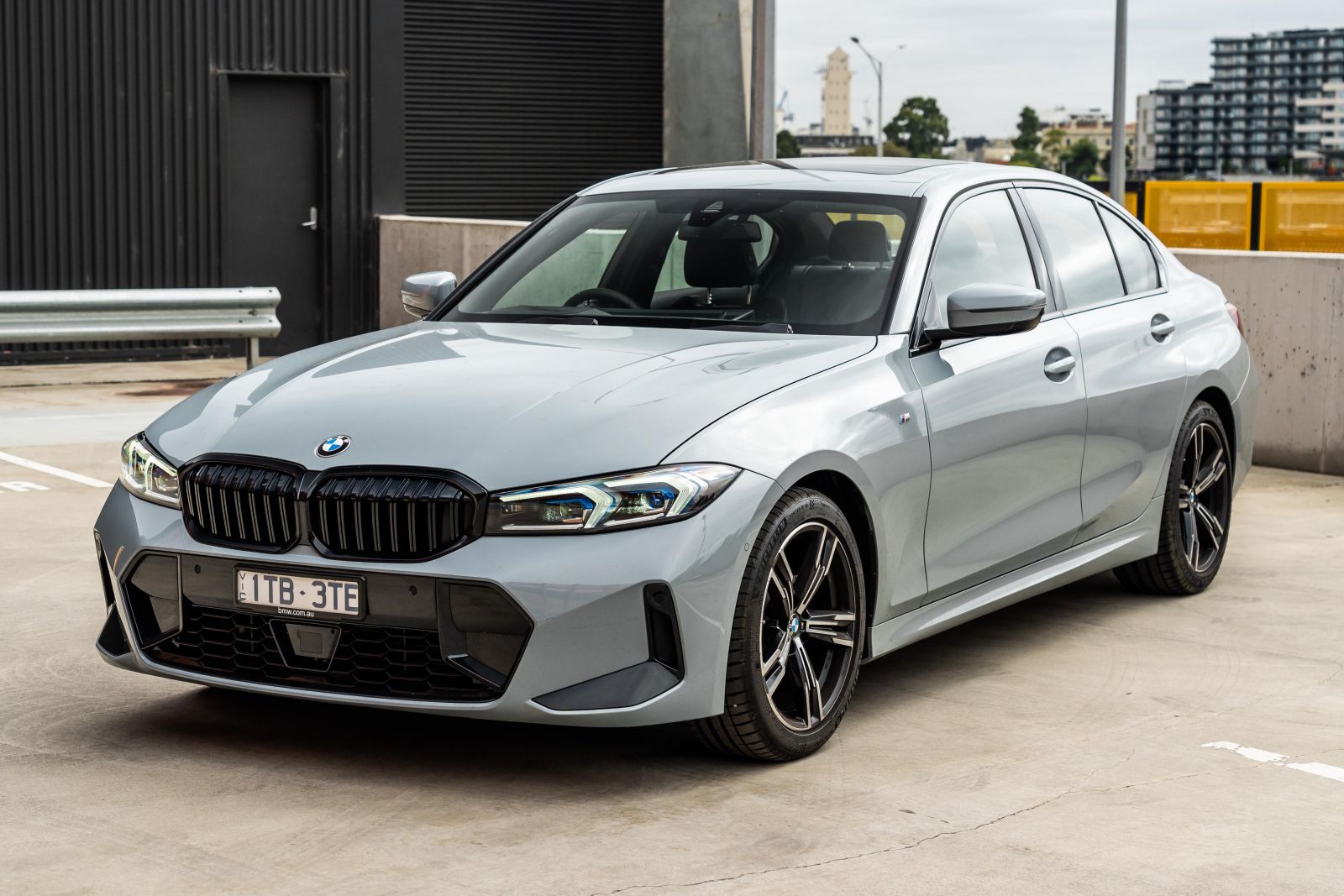The BMW 3 Series is a mid-sized luxury sedan staple.
It’s been at or close to the top of its class since the reign of the E30, and the latest G21 is no exception.
The pre-facelift model was our pick of the mid-sized sedan crop despite strong competition from the usual suspects at Mercedes-Benz and Audi, along with upstart challengers from Genesis and Alfa Romeo.
Along with a new look, the 320i wades into battle in 2023 with a higher price tag and an overhauled interior. Buttons are out and glossy, curved touchscreens are in, as BMW brings the 3er into line with the newer i4 and iX electric vehicles.
Has a mid-life nip-and-tuck improved on the 3 Series formula for 2023?
How much does the BMW 320i cost?
The BMW 3 Series has been hit with a significant price hike for 2023.
The base 320i on test here is $5400 more expensive than the car it replaces, while the 330i is up more than $10,000.
Even with that accounted for, the 3er represents solid value alongside the new Mercedes-Benz C-Class. The C200 kicks off at $81,700 before on-roads, and some of the equipment included on the 3er is hidden in an options package on the C.
The Audi A4 45 TFSI S line quattro is more powerful than the 320i, and features all-wheel drive, but undercuts the BMW with a sticker price of $75,700 before on-roads.
2023 BMW 3 Series pricing:
- BMW 320i: $78,900
- BMW 330i: $93,400
- BMW 330i Touring: $94,400
- BMW 330e: $97,400
- M340i xDrive: $104,990
All prices are before on-road costs
What is the BMW 320i like on the inside?
The big news behind the wheel is a pair of new, high-resolution screens. The last 3er wasn’t exactly old-fashioned, but the new model picks up the one-piece curved dashboard display debuted in the i4 and iX.
It looks incredibly modern, and there’s no doubt it’s cleaner than before, but it’s also harder to use.
BMW has axed the physical climate control buttons from the dashboard and buried them in the touchscreen. Although you can change the temperature without a sub-menu, but fan speed, direction, and recirculation are hidden.
Worse, you’re not able to use the rotary controller on the transmission tunnel to access that part of the infotainment system, it has to be touch-activated.
At risk of dedicating too much time to talking about one function of the car’s infotainment system, it’s infuriating that manufacturers continue to ignore usability in favour of clean looks… and the cost savings that come with axing small, fiddly buttons.
It’s also a shame because the rest of the technology in the 3er is excellent. The driver’s display looks modern and is easy to use on the move, the latest take on iDrive is fast and functional, and BMW has one of the most reliable wireless Apple CarPlay connections in the game.
BMW generally gets the driving position right, and that’s the case in the 3 Series. The driver’s seat drops right down to the floor, the steering wheel comes out nicely to meet the driver, and the seats themselves strike a nice blend between support and comfort.
They also look great in M Sport trim, with a lovely combination of suede-like inserts and faux leather bolsters. This might be a base model, but it doesn’t feel sparse or pared-back inside.
There’s plenty of storage spaces on offer, from the wireless phone charger and cupholders under a damped lid, to the decent-sized underarm bin. There are also door bins with space for big bottles, and a spacious glovebox.
Rear seat space is up there with the best in class, allowing for adults to sit behind adults provided neither is freakishly tall.
Headroom is also good, and the bench itself is wide enough to ride three-up for shorter trips. With a relatively conventional three-box design, you get plenty of light through the tall windows.
You get air vents in the rear, along with dual USB-C chargers to keep the kids happy. There’s a fold-down central armrest, and spacious door bins, and the door opening is wider than that of some lower-volume Korean and Italian rivals. That means you’re able to more easily load in children or bags.
There are ISOFIX points on the outboard rear seats, and three top-tether mounts for child seats.
Boot space is a claimed 480 litres, and the boot opening is impressively square and wide.
Although sedans aren’t known for the practicality in a world dominated by SUVs, there are a few neat little practical touches in the back of the latest 3er.
The rear bench folds 40/20/40, and there are deep pockets behind the wheel arches that are perfect for dirty shoes you want to keep separate from the rest of your cargo, or valuables you don’t want sliding around.
What’s under the bonnet?
The BMW 320i is powered by a 2.0-litre turbocharged four-cylinder engine producing 135kW of power and 300Nm of torque.
It’s mated with an eight-speed ZF torque converter automatic, and the 3er is rear-wheel drive.
Claimed fuel economy is 6.3 litres per 100km on the combined cycle, we saw 6.9L/100km over a week with a skew to highway driving.
The fuel tank holds 59 litres, and the 320i drinks 95 RON premium unleaded fuel.
How does the BMW 320i drive?
The engine and transmission in the 320i are unchanged for 2023, and based on our time behind the wheel Munich hasn’t messed with the suspension and steering much either. In the case of the engine, that’s a good thing.
The 2.0-litre used in the 320i and 330i is a peach, with plenty of low-down torque and a zingy top end that encourages you to push it hard in a way rival four-pot units don’t. It even makes a decent snarl when you put your foot down.
Even in its least powerful guise, the engine packs enough of a punch to make the 3er feel quick around town.
The eight-speed ZF transmission slurs smoothly through the lower gears on light throttle inputs to the point you can’t really feel it working or tell which gear you’re in, but it’s quick to kick down when you demand more performance and hangs onto gears smartly.
Although can you can take charge with the paddles (but not with the transmission selector anymore), it’s rare you’ll need to given how clever the car’s computer brain is. It’s also possible to flick into Sport using the stubby gear lever, which forces the car to hang onto a lower gear.
Unfortunately, BMW hasn’t improved on the choppy ride that afflicted the pre-update 320i. Where higher-end models feature adaptive dampers, the base car has a fixed-rate suspension that errs too far on the sporty side.
It never crashes or bashes into bumps, but it also never settles down. Over smaller imperfections it feels as if the car is constantly moving up and down, and the body doesn’t breathe when you hit larger crests or dips.
Body control is absolute – you could never accuse the 320i of feeling floaty – but it also never relaxes, which isn’t a particularly likeable trait in what’s meant to be a base model. Previous experience with a 3 Series featuring adaptive dampers revealed it’s a more comfortable car.
The fat-rimmed steering wheel won’t be to everyone’s taste but the steering is nice and direct, and the 3er still has a nice rear-wheel drive balance to it. Anyone hoping for an E30 reincarnated will be disappointed, but the world has moved on.
There’s still a strand of sporting DNA in the 3 Series, and that’s about all we can ask for.
What it’s lost in outright sportiness, it’s gained in refinement. Dimensionally the latest 3 is close to a match for the E39 5 Series, and the way it hums silently along at a cruise wouldn’t have felt out of place in an old 7 Series.
Coarse chip highways don’t completely undermine the refinement either, which isn’t always the case in German luxury cars.
With the semiconductor crunch hopefully abating, the 320i now features a full suite of active driver assists. The adaptive cruise and lane-keeping assist are smartly calibrated, and the excellent rear-view camera and parking sensors mean there’s no excuse for scraped wheels.
What do you get?
320i highlights:
- 18-inch M alloy wheels
- M Sport package
- LED headlights
- High-Beam Assistant
- 14.9-inch touchscreen infotainment system (NEW)
- 12.3-inch digital instrument cluster (NEW)
- Head-up display
- DAB+ digital radio
- Satellite navigation
- HiFi loudspeaker system
- Connected Package Professional
- Wireless charging tray
- Keyless entry with push-button start
- BMW Digital Key (NEW)
- Sport seats
- Alcantara/Sensatec upholstery
- Electric seat adjustment
- Ambient interior lighting
- Galvanic embellishers
Is the BMW 3 Series safe?
The pre-update BMW 3 Series was crash tested by ANCAP in 2019 and received a five-star safety rating. This rating doesn’t apply to the M340i xDrive, which remains unrated by ANCAP and Euro NCAP.
Standard safety features across the 3 Series range include:
- AEB with pedestrian detection
- Lane departure warning
- Blind-spot monitoring
- Driver attention monitoring
- Rear cross-traffic alert
- Adaptive cruise control
- Driving Assistant
- Semi-autonomous parking assist
- Reversing camera
- Front, rear parking sensors
- 8 airbags
The 330i and above get Parking Assistant Plus which includes a park view, panorama view and Remote 3D view functions.
Driving Assistant Professional, which includes Front cross-traffic alert and lane centring assist, is standard on the 330i and above, and is optional on the base 320i.
How much does the BMW 320i cost to run?
The BMW 3 Series range is covered by a five-year, unlimited-kilometre warranty with five years of roadside assist.
Having previously held out against the trend to longer warranties, BMW in 2021 confirmed it was ditching its three-year coverage in favour of a Mercedes-Benz and Audi-matching five-year warranty.
BMW offers a five-year/80,000km Service Inclusive Basic warranty package priced at $1800.
CarExpert’s Take on the BMW 320i
As was previously the case, the BMW 3 Series is a practical mid-sized sedan with something to offer people who drive for the sake of it, not just to get from one place to another.
It still shapes as the mid-sized luxury sedan to beat, but some of the changes BMW has made have the potential to loosen its grip on the crown.
The new infotainment system looks expensive, but it’s less user-friendly in a few key ways than the ostensibly lower-tech setup that came before it.
Given this is the entry point to the BMW 3 Series range, the price hike for 2023 also hurts.
A face-off with the new C-Class and the ageing but solid Audi A4 looms large in the future…
Click the images for the full gallery
MORE: Everything BMW 3 Series

















